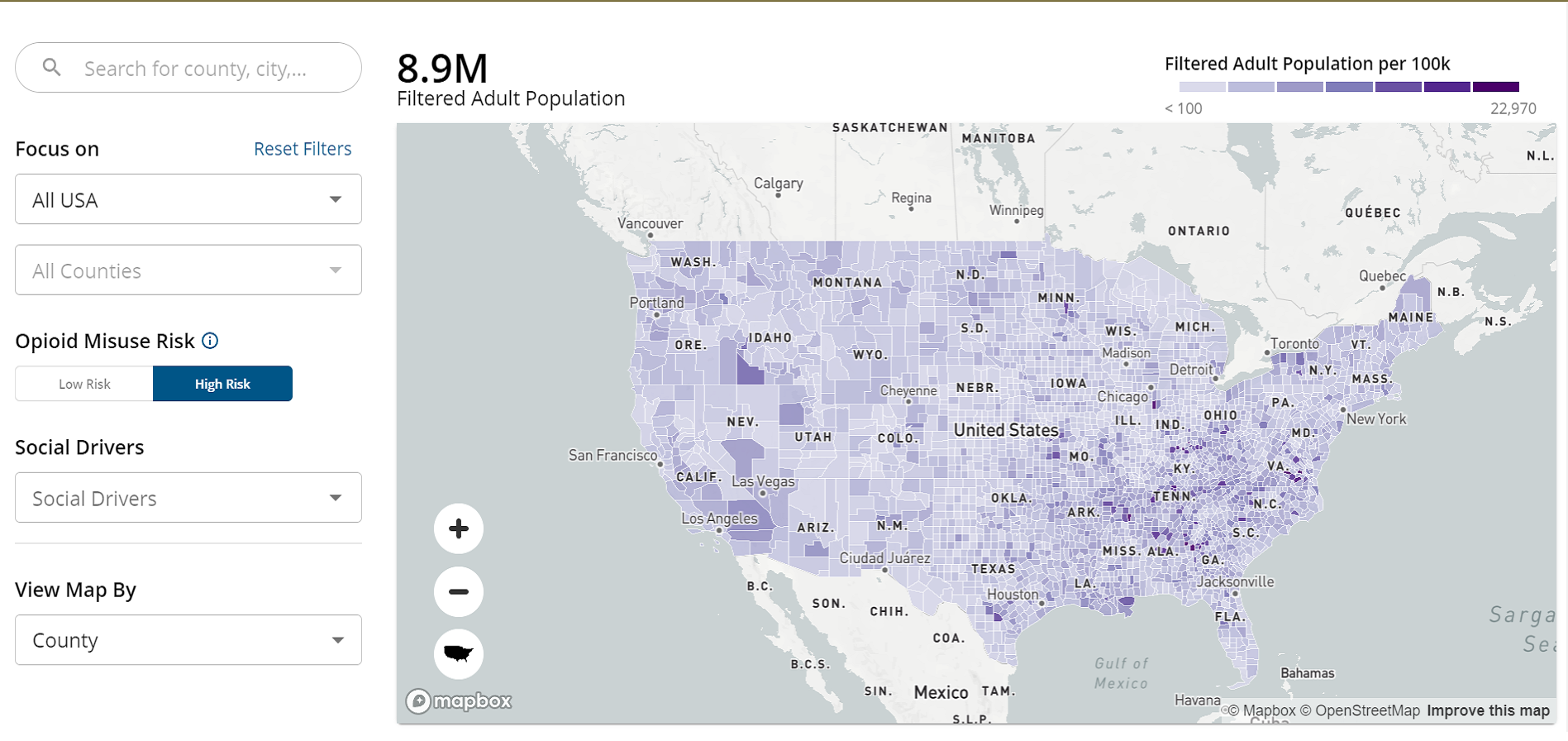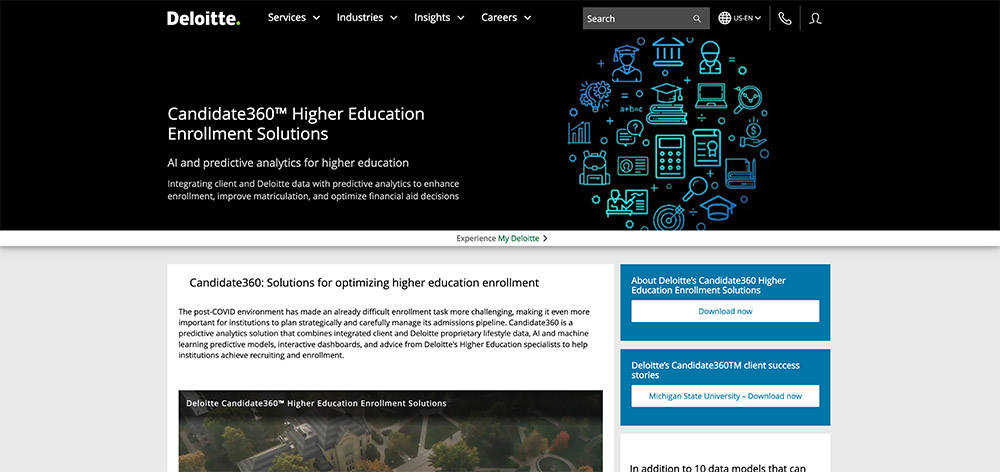
Empowers decision makers to improve outcomes
for communities they serve through cutting-edge AI, social drivers data, and geospatial analytics.
Largest social drivers of health dataset with data on 335M+ people in the US
Individual-level data with 8 years of history on 1,500+ data variables
Insight-generating predictive models driven by AI to reveal actionable social, economic, health, and lifestyle insights
Reveal deep insights on your
population
PeoplePrism creates a holistic picture of the people you serve, uncovers the barriers they face, identifies optimal messaging and outreach channels, and evaluates program efficacy.
Helping to Solve Your Challenges
Identify unique sub-populations
PeoplePrism can identify populations facing inequities based on social drivers and recommends programs tailored to individual needs.
Activate the community
PeoplePrism can identify optimal outreach methods, enabling micro-tailored communication campaigns to enhance program awareness.
Guide resource allocation
PeoplePrism can paint a holistic picture of people and their social drivers, identifying resource deserts and guiding solutions to close health equity gaps at the neighborhood-level.
Measure efficacy
PeoplePrism can evaluate policy and program efficacy using 8 years of longitudinal data, helping organizations achieve programmatic goals.
Get to know PeoplePrism
PeoplePrism can help you explore a wide variety of policy challenges impacting the populations you serve.
Across the country, parents are faced with the difficult task of finding and accessing affordable, high-quality child care. Child care providers continue to shut down due to insufficient funding and staffing shortages.
Simply stated, the demand exceeds the supply. Lack of child care, or child care “deserts,” is a serious problem that impacts both urban and rural areas. These shortages have downstream impacts on a variety of policy concerns, including workforce engagement and educational attainment.
In this example, use the map to find communities in Washington, DC most in-need of child care resources.
This dashboard was created using PeoplePrism and publicly available licensed child care provider data.
Who can benefit from PeoplePrism?
State Departments of Children and Families
State Departments of Veterans Affairs
State Departments of Human Services
Emergency Management Agencies
Federal Human Services Agencies
Federal Veterans Agencies
Non-profit Organizations
Any other organization connecting people with resources
PeoplePrism Success Stories
Kentucky Cabinet for Health and Family Services
Supplemental Nutrition Assistance Program (SNAP) Eligibility & Enrollment
A statewide matching and data filtering project that merged preexisting state SNAP enrollee data with Deloitte’s PeoplePrism data found that 39% of Kentucky adults who were likely eligible for SNAP benefits were not receiving this assistance.
We reached out to ~150,000 Kentucky adults with information about how to sign up for Kynect, Kentucky’s benefits portal.
As a result of these efforts,
12,000 new Kentucky
households applied for benefits
Veteran Affairs (VA) Office of Women’s Health (OWH)
VA Health Care in North Carolina
As the VA continues to expand women’s health services for Veterans, ensuring women Veterans are informed about their benefits is critical. The Veterans Affairs (VA) Office of Women’s Health (OWH) planned to host a series of in-person training sessions to increase VA health care enrollment among eligible Veterans.
VA OWH used PeoplePrism to strategically select locations for future training sessions based on demographic, social, health, and geographic information, ensuring that the training sessions were able to reach large numbers of eligible women Veterans.
VA OWH used PeoplePrism to ensure training sessions were able to reach large numbers of eligible women Veterans.
Frequently Asked Questions
Where do you get the data?
PeoplePrism data comes from over 50 large commercially available consumer marketing data sets as well as publicly available data from the CDC and the US Census.
What is different about this data?
PeoplePrism helps resolve data gaps that are common in publicly available data sources, such as underreporting of unhoused populations, by compiling data from over 50 data sources and using predictive modeling methods to accurately cover data gaps.
PeoplePrism can gives the ability to look at multiple data variables at once, enabling users to segment broad populations by multiple variables to find unique sub-populations.
How do you build predictive models?
PeoplePrism leverages semi-supervised machine learning (ML) methods to train explainable predictive models. PeoplePrism generates modeling datasets that represent the US population with respect to legally protected groups, including age, race, and gender. PeoplePrism extend bias checks further to include representation across income groups and the urban-rural continuum. Additionally, each variable input into a model is examined for its distribution with respect to age, race, gender, income, and the urban-rural continuum to help ensure that they do not act as a proxy for any of those variables. This bias awareness and examination can also influence the strategy for model selection where only explainable and interpretable models are used to train and predict risk.
How do you protect the data?
PeoplePrism is committed to maintaining the privacy of personal data, protecting user data and maintaining transparency with strict controls around data usage:
Is this real-time data?
PeoplePrism data reflects predictive estimates based on multiple demographic and consumer marketing data sources. PeoplePrism updates underlying data and risk estimates on a regular basis (typically every one to two months, depending on the source). In other words, the data in this dashboard is updated on a consistently recurring basis as opposed to a real-time basis.
How does PeoplePrism address gaps in race and ethnicity data?
Populations that suffer disproportionately high rates of death and disease—such as racially and ethnically diverse populations, people with disabilities, and rural populations—are underrepresented in some health research, and their status as part of those groups is often not recorded in critical health care records. This lack of data is a serious barrier to advancing equity.
Race and ethnicity data are particularly essential to understanding and improving equity. However, race and ethnicity data on much of the US population is missing from many health-related data sets. Race and ethnicity are often poorly documented in commercial health records like insurance claims. Additionally, gaps in data and outdated information in public data sources like the US Census can hinder meaningful insights into race and ethnicity. These gaps can prevent recognition of very real health disparities and delay action to improve equity.
To enable meaningful action on equity, PeoplePrism uses predictive models based on the Bayesian Improved Surname Geocoding Method (BISG) to fill the gaps in missing race and ethnicity data (this method is used by government agencies like the Virginia Department of Health). In addition, PeoplePrism uses other data science methods to improve race and ethnicity predictive model accuracy. PeoplePrism includes self-reported race where such data is available and displays predicted race where no self-reported data is available.
Contact Us
PeoplePrism's Lead Staff
Managing Director, Deloitte Consulting LLP
Chris Stehno
Principal, Deloitte Consulting LLP
Sean Conlin
Vice President, Product Strategy
Raaj Parekh

Senior Manager, Deloitte Consulting LLP
Mike Daggitt
More Solutions


